IKEA Case Study
VerifiedAdded on 2023/03/20
|10
|2804
|39
AI Summary
This case study explores IKEA's operations in Russia, including its expansion strategy, challenges faced, and ethical concerns. It discusses the impact of a healthy political machinery on business prospects and IKEA's strategy of creating large shopping complexes. The study also highlights the importance of understanding external elements while planning a market entry strategy.
Contribute Materials
Your contribution can guide someone’s learning journey. Share your
documents today.
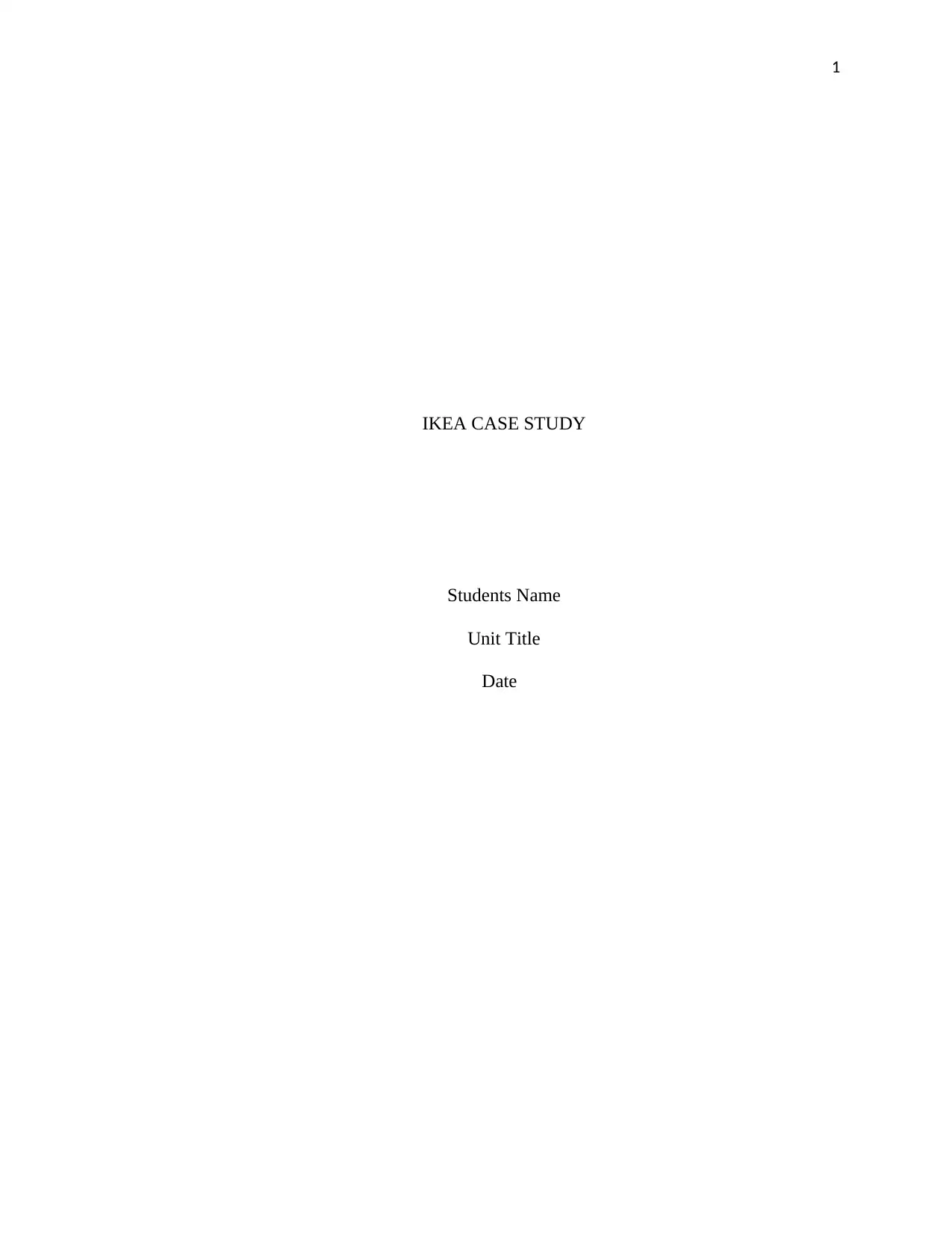
1
IKEA CASE STUDY
Students Name
Unit Title
Date
IKEA CASE STUDY
Students Name
Unit Title
Date
Secure Best Marks with AI Grader
Need help grading? Try our AI Grader for instant feedback on your assignments.
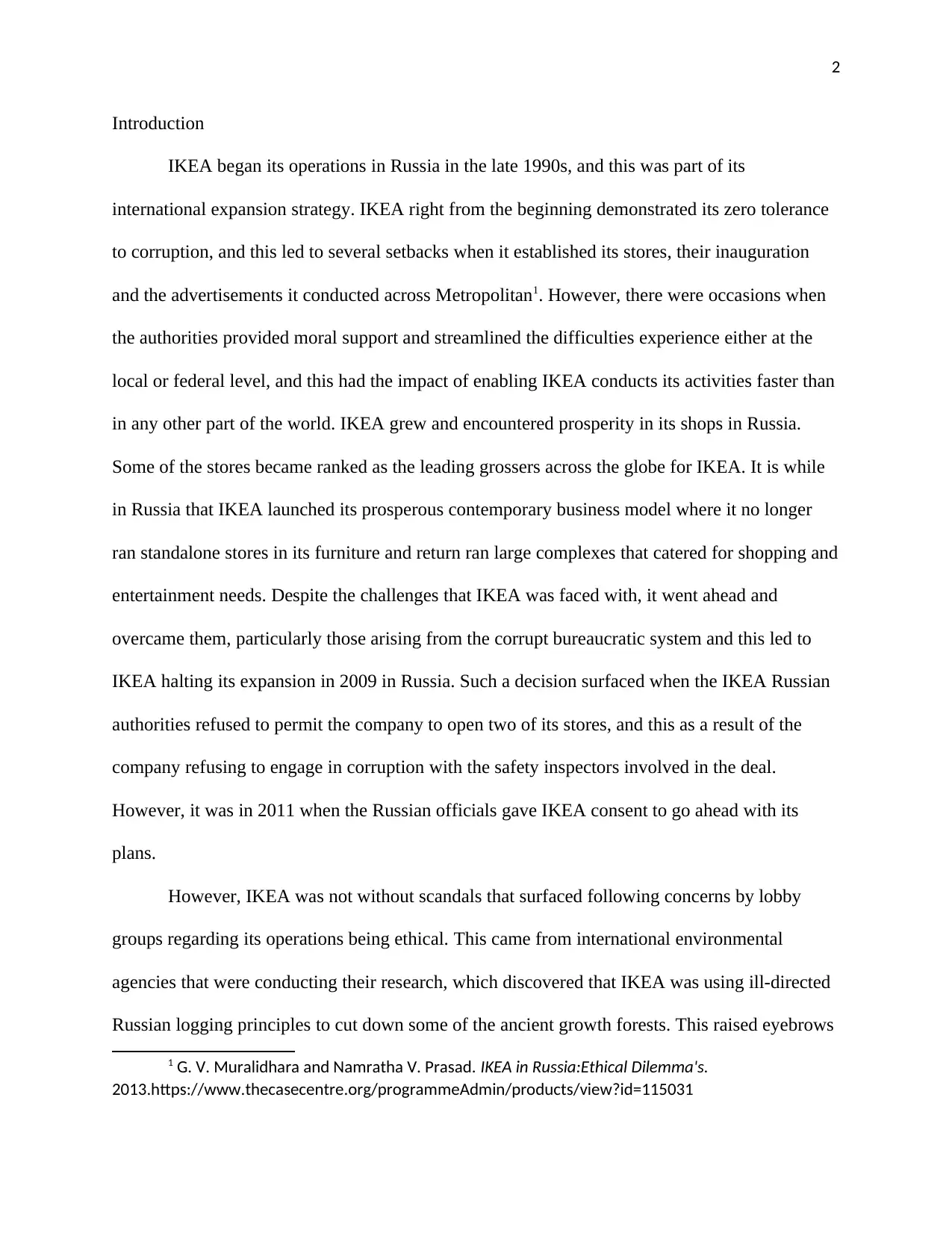
2
Introduction
IKEA began its operations in Russia in the late 1990s, and this was part of its
international expansion strategy. IKEA right from the beginning demonstrated its zero tolerance
to corruption, and this led to several setbacks when it established its stores, their inauguration
and the advertisements it conducted across Metropolitan1. However, there were occasions when
the authorities provided moral support and streamlined the difficulties experience either at the
local or federal level, and this had the impact of enabling IKEA conducts its activities faster than
in any other part of the world. IKEA grew and encountered prosperity in its shops in Russia.
Some of the stores became ranked as the leading grossers across the globe for IKEA. It is while
in Russia that IKEA launched its prosperous contemporary business model where it no longer
ran standalone stores in its furniture and return ran large complexes that catered for shopping and
entertainment needs. Despite the challenges that IKEA was faced with, it went ahead and
overcame them, particularly those arising from the corrupt bureaucratic system and this led to
IKEA halting its expansion in 2009 in Russia. Such a decision surfaced when the IKEA Russian
authorities refused to permit the company to open two of its stores, and this as a result of the
company refusing to engage in corruption with the safety inspectors involved in the deal.
However, it was in 2011 when the Russian officials gave IKEA consent to go ahead with its
plans.
However, IKEA was not without scandals that surfaced following concerns by lobby
groups regarding its operations being ethical. This came from international environmental
agencies that were conducting their research, which discovered that IKEA was using ill-directed
Russian logging principles to cut down some of the ancient growth forests. This raised eyebrows
1 G. V. Muralidhara and Namratha V. Prasad. IKEA in Russia:Ethical Dilemma's.
2013.https://www.thecasecentre.org/programmeAdmin/products/view?id=115031
Introduction
IKEA began its operations in Russia in the late 1990s, and this was part of its
international expansion strategy. IKEA right from the beginning demonstrated its zero tolerance
to corruption, and this led to several setbacks when it established its stores, their inauguration
and the advertisements it conducted across Metropolitan1. However, there were occasions when
the authorities provided moral support and streamlined the difficulties experience either at the
local or federal level, and this had the impact of enabling IKEA conducts its activities faster than
in any other part of the world. IKEA grew and encountered prosperity in its shops in Russia.
Some of the stores became ranked as the leading grossers across the globe for IKEA. It is while
in Russia that IKEA launched its prosperous contemporary business model where it no longer
ran standalone stores in its furniture and return ran large complexes that catered for shopping and
entertainment needs. Despite the challenges that IKEA was faced with, it went ahead and
overcame them, particularly those arising from the corrupt bureaucratic system and this led to
IKEA halting its expansion in 2009 in Russia. Such a decision surfaced when the IKEA Russian
authorities refused to permit the company to open two of its stores, and this as a result of the
company refusing to engage in corruption with the safety inspectors involved in the deal.
However, it was in 2011 when the Russian officials gave IKEA consent to go ahead with its
plans.
However, IKEA was not without scandals that surfaced following concerns by lobby
groups regarding its operations being ethical. This came from international environmental
agencies that were conducting their research, which discovered that IKEA was using ill-directed
Russian logging principles to cut down some of the ancient growth forests. This raised eyebrows
1 G. V. Muralidhara and Namratha V. Prasad. IKEA in Russia:Ethical Dilemma's.
2013.https://www.thecasecentre.org/programmeAdmin/products/view?id=115031
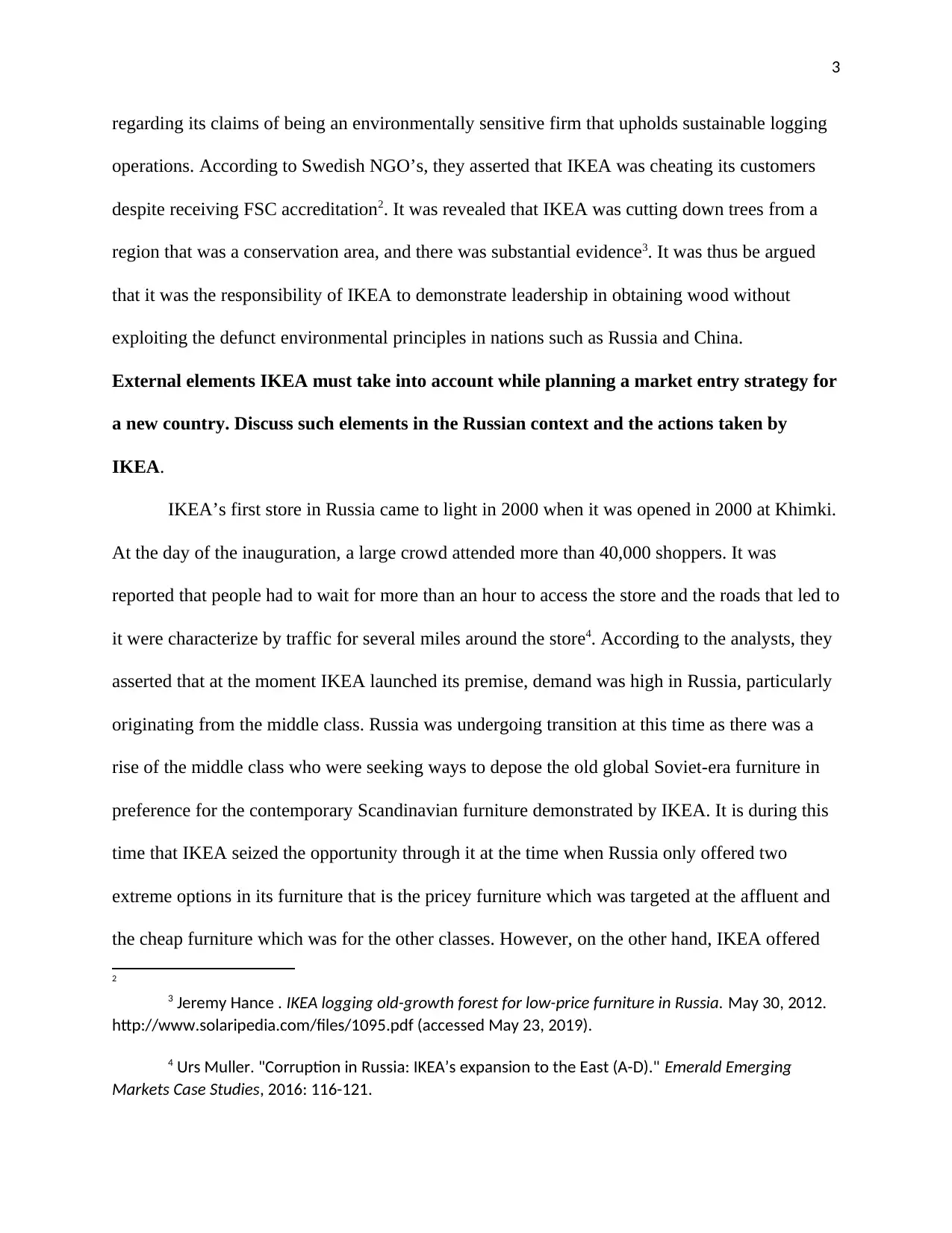
3
regarding its claims of being an environmentally sensitive firm that upholds sustainable logging
operations. According to Swedish NGO’s, they asserted that IKEA was cheating its customers
despite receiving FSC accreditation2. It was revealed that IKEA was cutting down trees from a
region that was a conservation area, and there was substantial evidence3. It was thus be argued
that it was the responsibility of IKEA to demonstrate leadership in obtaining wood without
exploiting the defunct environmental principles in nations such as Russia and China.
External elements IKEA must take into account while planning a market entry strategy for
a new country. Discuss such elements in the Russian context and the actions taken by
IKEA.
IKEA’s first store in Russia came to light in 2000 when it was opened in 2000 at Khimki.
At the day of the inauguration, a large crowd attended more than 40,000 shoppers. It was
reported that people had to wait for more than an hour to access the store and the roads that led to
it were characterize by traffic for several miles around the store4. According to the analysts, they
asserted that at the moment IKEA launched its premise, demand was high in Russia, particularly
originating from the middle class. Russia was undergoing transition at this time as there was a
rise of the middle class who were seeking ways to depose the old global Soviet-era furniture in
preference for the contemporary Scandinavian furniture demonstrated by IKEA. It is during this
time that IKEA seized the opportunity through it at the time when Russia only offered two
extreme options in its furniture that is the pricey furniture which was targeted at the affluent and
the cheap furniture which was for the other classes. However, on the other hand, IKEA offered
2
3 Jeremy Hance . IKEA logging old-growth forest for low-price furniture in Russia. May 30, 2012.
http://www.solaripedia.com/files/1095.pdf (accessed May 23, 2019).
4 Urs Muller. "Corruption in Russia: IKEA’s expansion to the East (A-D)." Emerald Emerging
Markets Case Studies, 2016: 116-121.
regarding its claims of being an environmentally sensitive firm that upholds sustainable logging
operations. According to Swedish NGO’s, they asserted that IKEA was cheating its customers
despite receiving FSC accreditation2. It was revealed that IKEA was cutting down trees from a
region that was a conservation area, and there was substantial evidence3. It was thus be argued
that it was the responsibility of IKEA to demonstrate leadership in obtaining wood without
exploiting the defunct environmental principles in nations such as Russia and China.
External elements IKEA must take into account while planning a market entry strategy for
a new country. Discuss such elements in the Russian context and the actions taken by
IKEA.
IKEA’s first store in Russia came to light in 2000 when it was opened in 2000 at Khimki.
At the day of the inauguration, a large crowd attended more than 40,000 shoppers. It was
reported that people had to wait for more than an hour to access the store and the roads that led to
it were characterize by traffic for several miles around the store4. According to the analysts, they
asserted that at the moment IKEA launched its premise, demand was high in Russia, particularly
originating from the middle class. Russia was undergoing transition at this time as there was a
rise of the middle class who were seeking ways to depose the old global Soviet-era furniture in
preference for the contemporary Scandinavian furniture demonstrated by IKEA. It is during this
time that IKEA seized the opportunity through it at the time when Russia only offered two
extreme options in its furniture that is the pricey furniture which was targeted at the affluent and
the cheap furniture which was for the other classes. However, on the other hand, IKEA offered
2
3 Jeremy Hance . IKEA logging old-growth forest for low-price furniture in Russia. May 30, 2012.
http://www.solaripedia.com/files/1095.pdf (accessed May 23, 2019).
4 Urs Muller. "Corruption in Russia: IKEA’s expansion to the East (A-D)." Emerald Emerging
Markets Case Studies, 2016: 116-121.
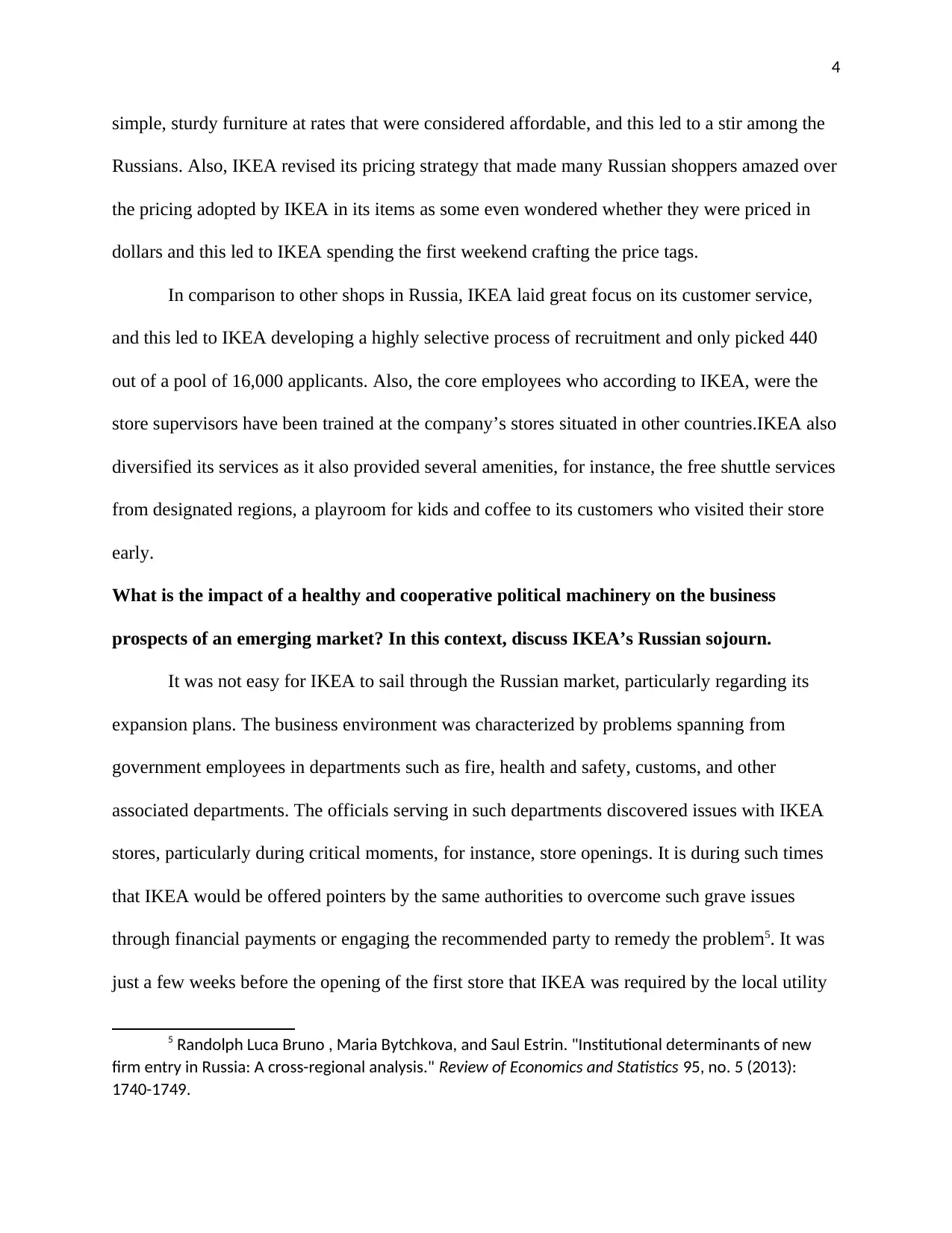
4
simple, sturdy furniture at rates that were considered affordable, and this led to a stir among the
Russians. Also, IKEA revised its pricing strategy that made many Russian shoppers amazed over
the pricing adopted by IKEA in its items as some even wondered whether they were priced in
dollars and this led to IKEA spending the first weekend crafting the price tags.
In comparison to other shops in Russia, IKEA laid great focus on its customer service,
and this led to IKEA developing a highly selective process of recruitment and only picked 440
out of a pool of 16,000 applicants. Also, the core employees who according to IKEA, were the
store supervisors have been trained at the company’s stores situated in other countries.IKEA also
diversified its services as it also provided several amenities, for instance, the free shuttle services
from designated regions, a playroom for kids and coffee to its customers who visited their store
early.
What is the impact of a healthy and cooperative political machinery on the business
prospects of an emerging market? In this context, discuss IKEA’s Russian sojourn.
It was not easy for IKEA to sail through the Russian market, particularly regarding its
expansion plans. The business environment was characterized by problems spanning from
government employees in departments such as fire, health and safety, customs, and other
associated departments. The officials serving in such departments discovered issues with IKEA
stores, particularly during critical moments, for instance, store openings. It is during such times
that IKEA would be offered pointers by the same authorities to overcome such grave issues
through financial payments or engaging the recommended party to remedy the problem5. It was
just a few weeks before the opening of the first store that IKEA was required by the local utility
5 Randolph Luca Bruno , Maria Bytchkova, and Saul Estrin. "Institutional determinants of new
firm entry in Russia: A cross-regional analysis." Review of Economics and Statistics 95, no. 5 (2013):
1740-1749.
simple, sturdy furniture at rates that were considered affordable, and this led to a stir among the
Russians. Also, IKEA revised its pricing strategy that made many Russian shoppers amazed over
the pricing adopted by IKEA in its items as some even wondered whether they were priced in
dollars and this led to IKEA spending the first weekend crafting the price tags.
In comparison to other shops in Russia, IKEA laid great focus on its customer service,
and this led to IKEA developing a highly selective process of recruitment and only picked 440
out of a pool of 16,000 applicants. Also, the core employees who according to IKEA, were the
store supervisors have been trained at the company’s stores situated in other countries.IKEA also
diversified its services as it also provided several amenities, for instance, the free shuttle services
from designated regions, a playroom for kids and coffee to its customers who visited their store
early.
What is the impact of a healthy and cooperative political machinery on the business
prospects of an emerging market? In this context, discuss IKEA’s Russian sojourn.
It was not easy for IKEA to sail through the Russian market, particularly regarding its
expansion plans. The business environment was characterized by problems spanning from
government employees in departments such as fire, health and safety, customs, and other
associated departments. The officials serving in such departments discovered issues with IKEA
stores, particularly during critical moments, for instance, store openings. It is during such times
that IKEA would be offered pointers by the same authorities to overcome such grave issues
through financial payments or engaging the recommended party to remedy the problem5. It was
just a few weeks before the opening of the first store that IKEA was required by the local utility
5 Randolph Luca Bruno , Maria Bytchkova, and Saul Estrin. "Institutional determinants of new
firm entry in Russia: A cross-regional analysis." Review of Economics and Statistics 95, no. 5 (2013):
1740-1749.
Secure Best Marks with AI Grader
Need help grading? Try our AI Grader for instant feedback on your assignments.
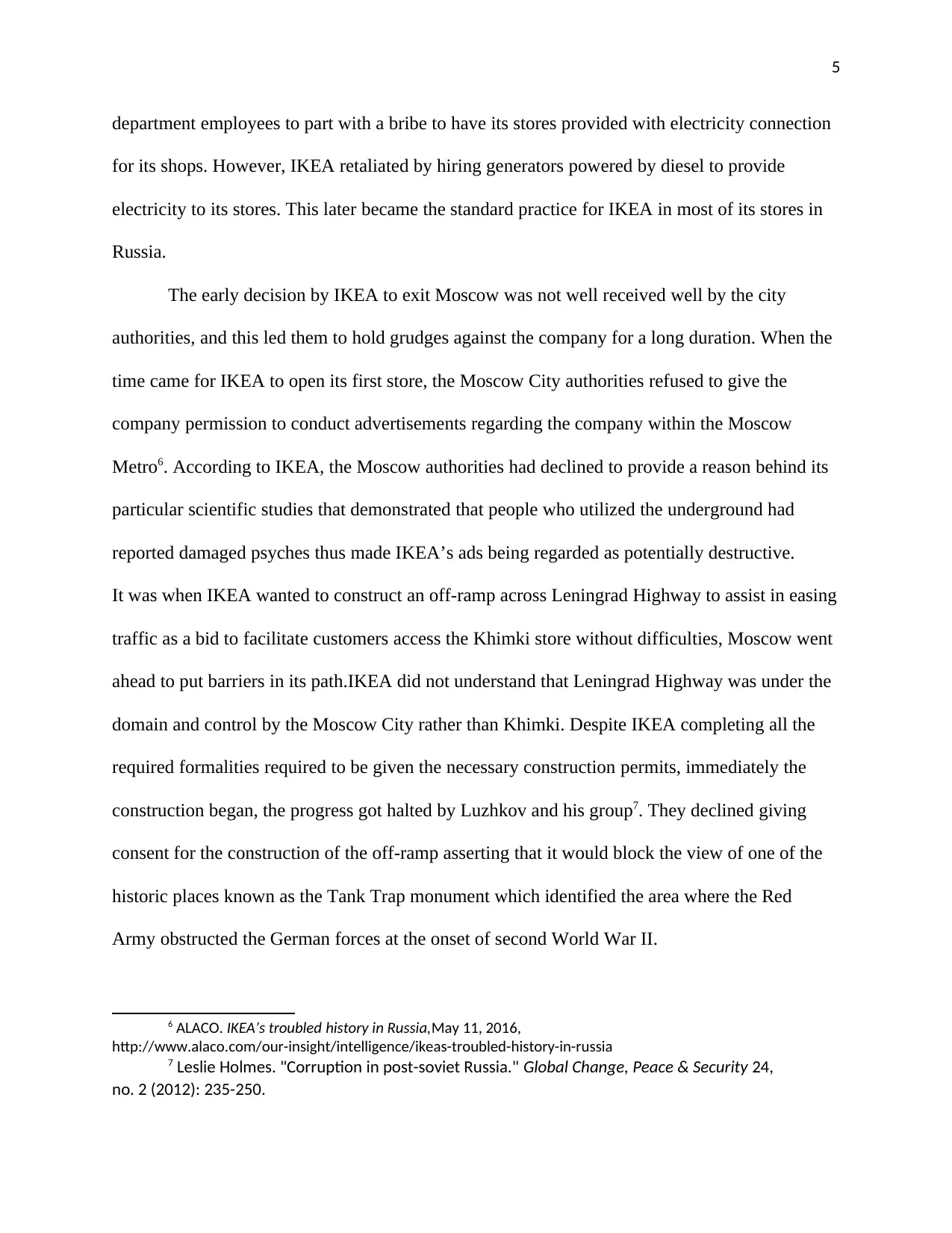
5
department employees to part with a bribe to have its stores provided with electricity connection
for its shops. However, IKEA retaliated by hiring generators powered by diesel to provide
electricity to its stores. This later became the standard practice for IKEA in most of its stores in
Russia.
The early decision by IKEA to exit Moscow was not well received well by the city
authorities, and this led them to hold grudges against the company for a long duration. When the
time came for IKEA to open its first store, the Moscow City authorities refused to give the
company permission to conduct advertisements regarding the company within the Moscow
Metro6. According to IKEA, the Moscow authorities had declined to provide a reason behind its
particular scientific studies that demonstrated that people who utilized the underground had
reported damaged psyches thus made IKEA’s ads being regarded as potentially destructive.
It was when IKEA wanted to construct an off-ramp across Leningrad Highway to assist in easing
traffic as a bid to facilitate customers access the Khimki store without difficulties, Moscow went
ahead to put barriers in its path.IKEA did not understand that Leningrad Highway was under the
domain and control by the Moscow City rather than Khimki. Despite IKEA completing all the
required formalities required to be given the necessary construction permits, immediately the
construction began, the progress got halted by Luzhkov and his group7. They declined giving
consent for the construction of the off-ramp asserting that it would block the view of one of the
historic places known as the Tank Trap monument which identified the area where the Red
Army obstructed the German forces at the onset of second World War II.
6 ALACO. IKEA’s troubled history in Russia,May 11, 2016,
http://www.alaco.com/our-insight/intelligence/ikeas-troubled-history-in-russia
7 Leslie Holmes. "Corruption in post-soviet Russia." Global Change, Peace & Security 24,
no. 2 (2012): 235-250.
department employees to part with a bribe to have its stores provided with electricity connection
for its shops. However, IKEA retaliated by hiring generators powered by diesel to provide
electricity to its stores. This later became the standard practice for IKEA in most of its stores in
Russia.
The early decision by IKEA to exit Moscow was not well received well by the city
authorities, and this led them to hold grudges against the company for a long duration. When the
time came for IKEA to open its first store, the Moscow City authorities refused to give the
company permission to conduct advertisements regarding the company within the Moscow
Metro6. According to IKEA, the Moscow authorities had declined to provide a reason behind its
particular scientific studies that demonstrated that people who utilized the underground had
reported damaged psyches thus made IKEA’s ads being regarded as potentially destructive.
It was when IKEA wanted to construct an off-ramp across Leningrad Highway to assist in easing
traffic as a bid to facilitate customers access the Khimki store without difficulties, Moscow went
ahead to put barriers in its path.IKEA did not understand that Leningrad Highway was under the
domain and control by the Moscow City rather than Khimki. Despite IKEA completing all the
required formalities required to be given the necessary construction permits, immediately the
construction began, the progress got halted by Luzhkov and his group7. They declined giving
consent for the construction of the off-ramp asserting that it would block the view of one of the
historic places known as the Tank Trap monument which identified the area where the Red
Army obstructed the German forces at the onset of second World War II.
6 ALACO. IKEA’s troubled history in Russia,May 11, 2016,
http://www.alaco.com/our-insight/intelligence/ikeas-troubled-history-in-russia
7 Leslie Holmes. "Corruption in post-soviet Russia." Global Change, Peace & Security 24,
no. 2 (2012): 235-250.
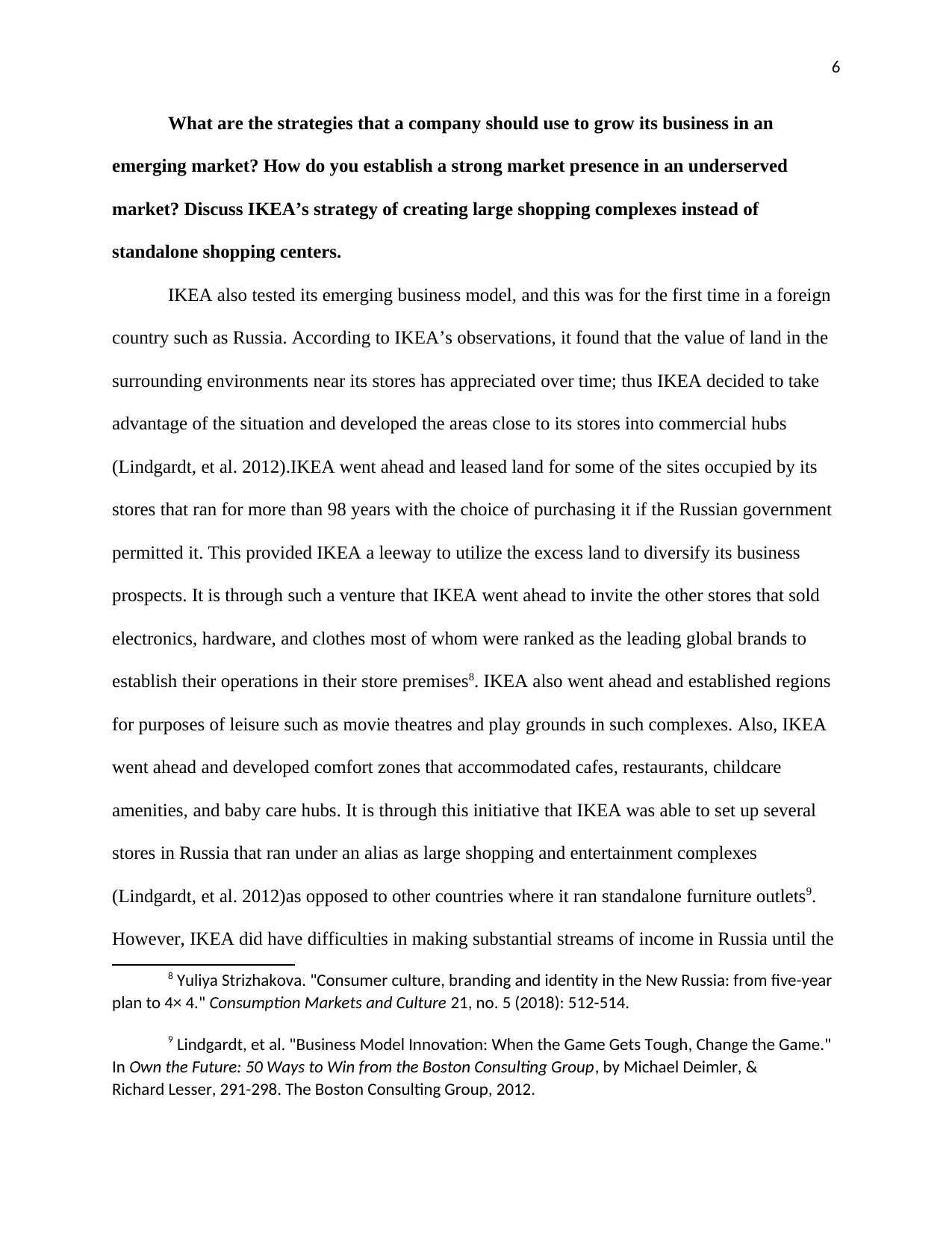
6
What are the strategies that a company should use to grow its business in an
emerging market? How do you establish a strong market presence in an underserved
market? Discuss IKEA’s strategy of creating large shopping complexes instead of
standalone shopping centers.
IKEA also tested its emerging business model, and this was for the first time in a foreign
country such as Russia. According to IKEA’s observations, it found that the value of land in the
surrounding environments near its stores has appreciated over time; thus IKEA decided to take
advantage of the situation and developed the areas close to its stores into commercial hubs
(Lindgardt, et al. 2012).IKEA went ahead and leased land for some of the sites occupied by its
stores that ran for more than 98 years with the choice of purchasing it if the Russian government
permitted it. This provided IKEA a leeway to utilize the excess land to diversify its business
prospects. It is through such a venture that IKEA went ahead to invite the other stores that sold
electronics, hardware, and clothes most of whom were ranked as the leading global brands to
establish their operations in their store premises8. IKEA also went ahead and established regions
for purposes of leisure such as movie theatres and play grounds in such complexes. Also, IKEA
went ahead and developed comfort zones that accommodated cafes, restaurants, childcare
amenities, and baby care hubs. It is through this initiative that IKEA was able to set up several
stores in Russia that ran under an alias as large shopping and entertainment complexes
(Lindgardt, et al. 2012)as opposed to other countries where it ran standalone furniture outlets9.
However, IKEA did have difficulties in making substantial streams of income in Russia until the
8 Yuliya Strizhakova. "Consumer culture, branding and identity in the New Russia: from five-year
plan to 4× 4." Consumption Markets and Culture 21, no. 5 (2018): 512-514.
9 Lindgardt, et al. "Business Model Innovation: When the Game Gets Tough, Change the Game."
In Own the Future: 50 Ways to Win from the Boston Consulting Group, by Michael Deimler, &
Richard Lesser, 291-298. The Boston Consulting Group, 2012.
What are the strategies that a company should use to grow its business in an
emerging market? How do you establish a strong market presence in an underserved
market? Discuss IKEA’s strategy of creating large shopping complexes instead of
standalone shopping centers.
IKEA also tested its emerging business model, and this was for the first time in a foreign
country such as Russia. According to IKEA’s observations, it found that the value of land in the
surrounding environments near its stores has appreciated over time; thus IKEA decided to take
advantage of the situation and developed the areas close to its stores into commercial hubs
(Lindgardt, et al. 2012).IKEA went ahead and leased land for some of the sites occupied by its
stores that ran for more than 98 years with the choice of purchasing it if the Russian government
permitted it. This provided IKEA a leeway to utilize the excess land to diversify its business
prospects. It is through such a venture that IKEA went ahead to invite the other stores that sold
electronics, hardware, and clothes most of whom were ranked as the leading global brands to
establish their operations in their store premises8. IKEA also went ahead and established regions
for purposes of leisure such as movie theatres and play grounds in such complexes. Also, IKEA
went ahead and developed comfort zones that accommodated cafes, restaurants, childcare
amenities, and baby care hubs. It is through this initiative that IKEA was able to set up several
stores in Russia that ran under an alias as large shopping and entertainment complexes
(Lindgardt, et al. 2012)as opposed to other countries where it ran standalone furniture outlets9.
However, IKEA did have difficulties in making substantial streams of income in Russia until the
8 Yuliya Strizhakova. "Consumer culture, branding and identity in the New Russia: from five-year
plan to 4× 4." Consumption Markets and Culture 21, no. 5 (2018): 512-514.
9 Lindgardt, et al. "Business Model Innovation: When the Game Gets Tough, Change the Game."
In Own the Future: 50 Ways to Win from the Boston Consulting Group, by Michael Deimler, &
Richard Lesser, 291-298. The Boston Consulting Group, 2012.
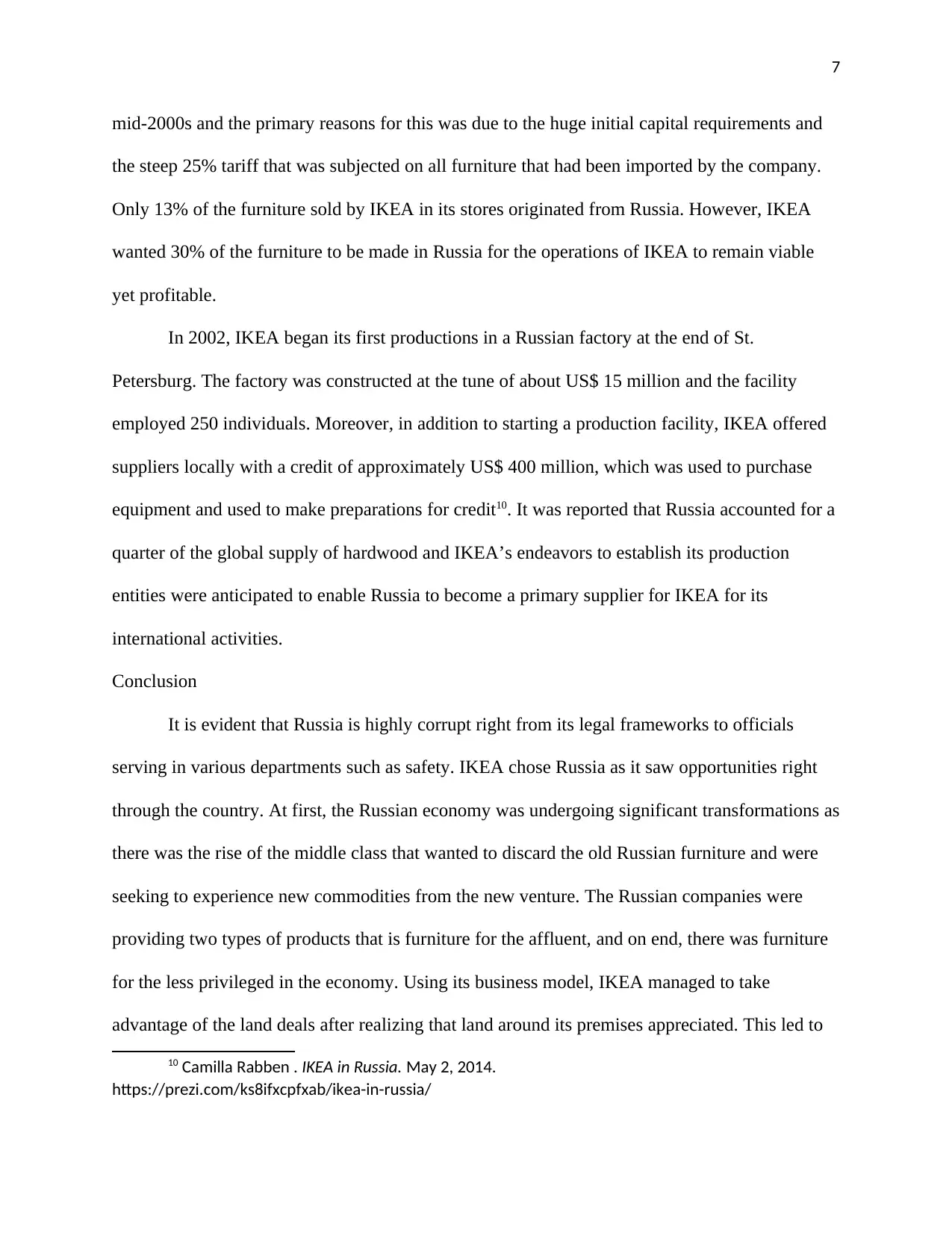
7
mid-2000s and the primary reasons for this was due to the huge initial capital requirements and
the steep 25% tariff that was subjected on all furniture that had been imported by the company.
Only 13% of the furniture sold by IKEA in its stores originated from Russia. However, IKEA
wanted 30% of the furniture to be made in Russia for the operations of IKEA to remain viable
yet profitable.
In 2002, IKEA began its first productions in a Russian factory at the end of St.
Petersburg. The factory was constructed at the tune of about US$ 15 million and the facility
employed 250 individuals. Moreover, in addition to starting a production facility, IKEA offered
suppliers locally with a credit of approximately US$ 400 million, which was used to purchase
equipment and used to make preparations for credit10. It was reported that Russia accounted for a
quarter of the global supply of hardwood and IKEA’s endeavors to establish its production
entities were anticipated to enable Russia to become a primary supplier for IKEA for its
international activities.
Conclusion
It is evident that Russia is highly corrupt right from its legal frameworks to officials
serving in various departments such as safety. IKEA chose Russia as it saw opportunities right
through the country. At first, the Russian economy was undergoing significant transformations as
there was the rise of the middle class that wanted to discard the old Russian furniture and were
seeking to experience new commodities from the new venture. The Russian companies were
providing two types of products that is furniture for the affluent, and on end, there was furniture
for the less privileged in the economy. Using its business model, IKEA managed to take
advantage of the land deals after realizing that land around its premises appreciated. This led to
10 Camilla Rabben . IKEA in Russia. May 2, 2014.
https://prezi.com/ks8ifxcpfxab/ikea-in-russia/
mid-2000s and the primary reasons for this was due to the huge initial capital requirements and
the steep 25% tariff that was subjected on all furniture that had been imported by the company.
Only 13% of the furniture sold by IKEA in its stores originated from Russia. However, IKEA
wanted 30% of the furniture to be made in Russia for the operations of IKEA to remain viable
yet profitable.
In 2002, IKEA began its first productions in a Russian factory at the end of St.
Petersburg. The factory was constructed at the tune of about US$ 15 million and the facility
employed 250 individuals. Moreover, in addition to starting a production facility, IKEA offered
suppliers locally with a credit of approximately US$ 400 million, which was used to purchase
equipment and used to make preparations for credit10. It was reported that Russia accounted for a
quarter of the global supply of hardwood and IKEA’s endeavors to establish its production
entities were anticipated to enable Russia to become a primary supplier for IKEA for its
international activities.
Conclusion
It is evident that Russia is highly corrupt right from its legal frameworks to officials
serving in various departments such as safety. IKEA chose Russia as it saw opportunities right
through the country. At first, the Russian economy was undergoing significant transformations as
there was the rise of the middle class that wanted to discard the old Russian furniture and were
seeking to experience new commodities from the new venture. The Russian companies were
providing two types of products that is furniture for the affluent, and on end, there was furniture
for the less privileged in the economy. Using its business model, IKEA managed to take
advantage of the land deals after realizing that land around its premises appreciated. This led to
10 Camilla Rabben . IKEA in Russia. May 2, 2014.
https://prezi.com/ks8ifxcpfxab/ikea-in-russia/
Paraphrase This Document
Need a fresh take? Get an instant paraphrase of this document with our AI Paraphraser
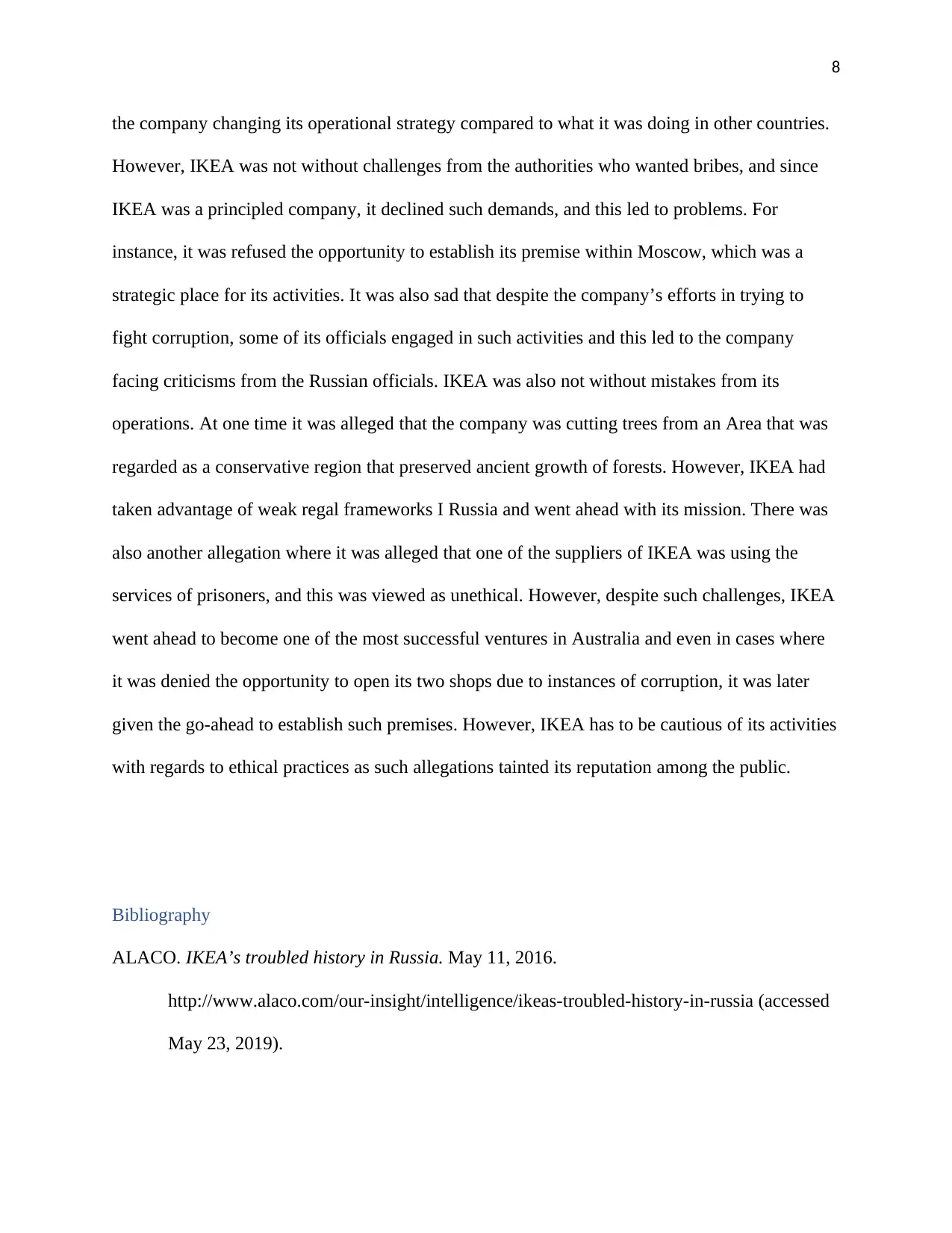
8
the company changing its operational strategy compared to what it was doing in other countries.
However, IKEA was not without challenges from the authorities who wanted bribes, and since
IKEA was a principled company, it declined such demands, and this led to problems. For
instance, it was refused the opportunity to establish its premise within Moscow, which was a
strategic place for its activities. It was also sad that despite the company’s efforts in trying to
fight corruption, some of its officials engaged in such activities and this led to the company
facing criticisms from the Russian officials. IKEA was also not without mistakes from its
operations. At one time it was alleged that the company was cutting trees from an Area that was
regarded as a conservative region that preserved ancient growth of forests. However, IKEA had
taken advantage of weak regal frameworks I Russia and went ahead with its mission. There was
also another allegation where it was alleged that one of the suppliers of IKEA was using the
services of prisoners, and this was viewed as unethical. However, despite such challenges, IKEA
went ahead to become one of the most successful ventures in Australia and even in cases where
it was denied the opportunity to open its two shops due to instances of corruption, it was later
given the go-ahead to establish such premises. However, IKEA has to be cautious of its activities
with regards to ethical practices as such allegations tainted its reputation among the public.
Bibliography
ALACO. IKEA’s troubled history in Russia. May 11, 2016.
http://www.alaco.com/our-insight/intelligence/ikeas-troubled-history-in-russia (accessed
May 23, 2019).
the company changing its operational strategy compared to what it was doing in other countries.
However, IKEA was not without challenges from the authorities who wanted bribes, and since
IKEA was a principled company, it declined such demands, and this led to problems. For
instance, it was refused the opportunity to establish its premise within Moscow, which was a
strategic place for its activities. It was also sad that despite the company’s efforts in trying to
fight corruption, some of its officials engaged in such activities and this led to the company
facing criticisms from the Russian officials. IKEA was also not without mistakes from its
operations. At one time it was alleged that the company was cutting trees from an Area that was
regarded as a conservative region that preserved ancient growth of forests. However, IKEA had
taken advantage of weak regal frameworks I Russia and went ahead with its mission. There was
also another allegation where it was alleged that one of the suppliers of IKEA was using the
services of prisoners, and this was viewed as unethical. However, despite such challenges, IKEA
went ahead to become one of the most successful ventures in Australia and even in cases where
it was denied the opportunity to open its two shops due to instances of corruption, it was later
given the go-ahead to establish such premises. However, IKEA has to be cautious of its activities
with regards to ethical practices as such allegations tainted its reputation among the public.
Bibliography
ALACO. IKEA’s troubled history in Russia. May 11, 2016.
http://www.alaco.com/our-insight/intelligence/ikeas-troubled-history-in-russia (accessed
May 23, 2019).
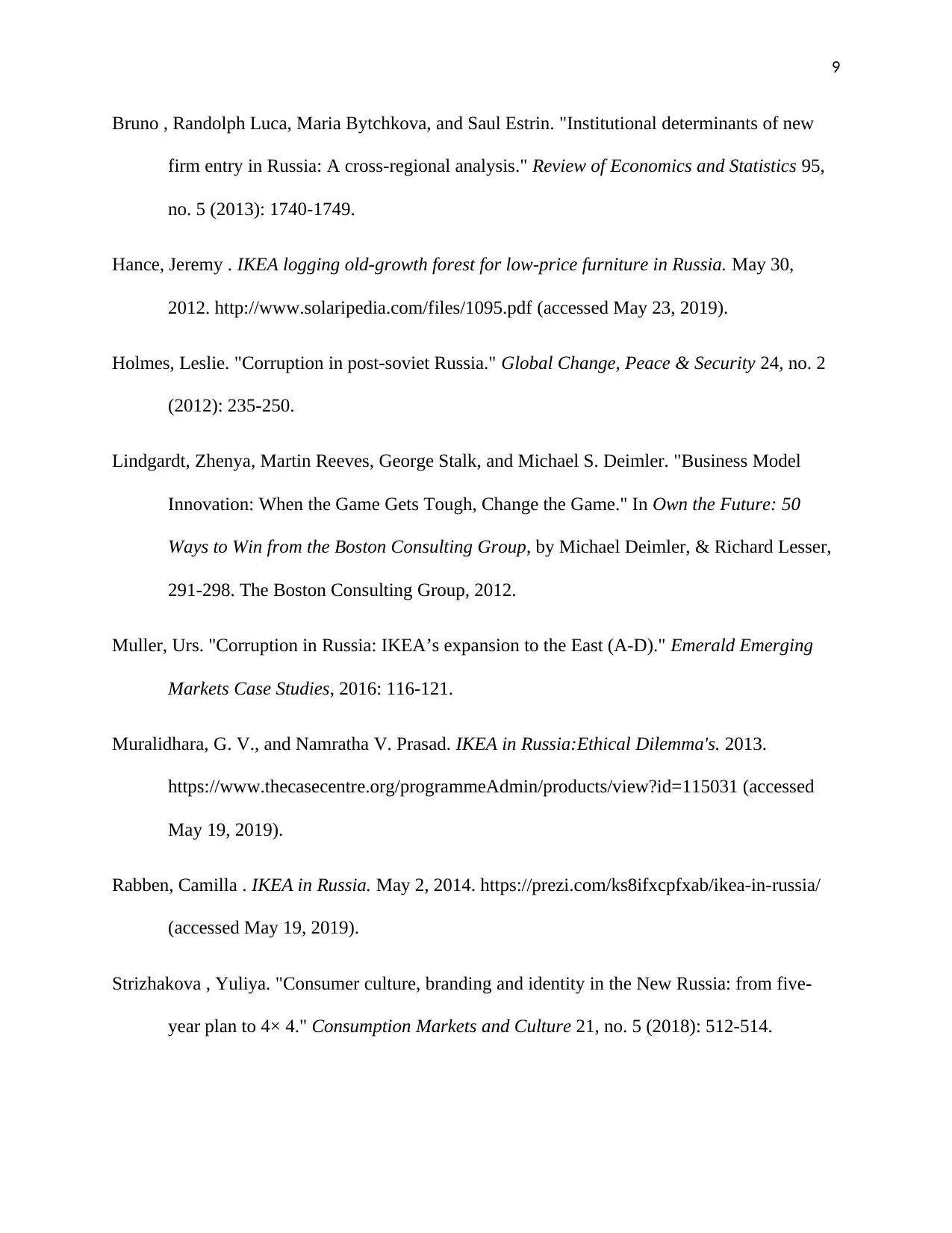
9
Bruno , Randolph Luca, Maria Bytchkova, and Saul Estrin. "Institutional determinants of new
firm entry in Russia: A cross-regional analysis." Review of Economics and Statistics 95,
no. 5 (2013): 1740-1749.
Hance, Jeremy . IKEA logging old-growth forest for low-price furniture in Russia. May 30,
2012. http://www.solaripedia.com/files/1095.pdf (accessed May 23, 2019).
Holmes, Leslie. "Corruption in post-soviet Russia." Global Change, Peace & Security 24, no. 2
(2012): 235-250.
Lindgardt, Zhenya, Martin Reeves, George Stalk, and Michael S. Deimler. "Business Model
Innovation: When the Game Gets Tough, Change the Game." In Own the Future: 50
Ways to Win from the Boston Consulting Group, by Michael Deimler, & Richard Lesser,
291-298. The Boston Consulting Group, 2012.
Muller, Urs. "Corruption in Russia: IKEA’s expansion to the East (A-D)." Emerald Emerging
Markets Case Studies, 2016: 116-121.
Muralidhara, G. V., and Namratha V. Prasad. IKEA in Russia:Ethical Dilemma's. 2013.
https://www.thecasecentre.org/programmeAdmin/products/view?id=115031 (accessed
May 19, 2019).
Rabben, Camilla . IKEA in Russia. May 2, 2014. https://prezi.com/ks8ifxcpfxab/ikea-in-russia/
(accessed May 19, 2019).
Strizhakova , Yuliya. "Consumer culture, branding and identity in the New Russia: from five-
year plan to 4× 4." Consumption Markets and Culture 21, no. 5 (2018): 512-514.
Bruno , Randolph Luca, Maria Bytchkova, and Saul Estrin. "Institutional determinants of new
firm entry in Russia: A cross-regional analysis." Review of Economics and Statistics 95,
no. 5 (2013): 1740-1749.
Hance, Jeremy . IKEA logging old-growth forest for low-price furniture in Russia. May 30,
2012. http://www.solaripedia.com/files/1095.pdf (accessed May 23, 2019).
Holmes, Leslie. "Corruption in post-soviet Russia." Global Change, Peace & Security 24, no. 2
(2012): 235-250.
Lindgardt, Zhenya, Martin Reeves, George Stalk, and Michael S. Deimler. "Business Model
Innovation: When the Game Gets Tough, Change the Game." In Own the Future: 50
Ways to Win from the Boston Consulting Group, by Michael Deimler, & Richard Lesser,
291-298. The Boston Consulting Group, 2012.
Muller, Urs. "Corruption in Russia: IKEA’s expansion to the East (A-D)." Emerald Emerging
Markets Case Studies, 2016: 116-121.
Muralidhara, G. V., and Namratha V. Prasad. IKEA in Russia:Ethical Dilemma's. 2013.
https://www.thecasecentre.org/programmeAdmin/products/view?id=115031 (accessed
May 19, 2019).
Rabben, Camilla . IKEA in Russia. May 2, 2014. https://prezi.com/ks8ifxcpfxab/ikea-in-russia/
(accessed May 19, 2019).
Strizhakova , Yuliya. "Consumer culture, branding and identity in the New Russia: from five-
year plan to 4× 4." Consumption Markets and Culture 21, no. 5 (2018): 512-514.

10
1 out of 10
Your All-in-One AI-Powered Toolkit for Academic Success.
+13062052269
info@desklib.com
Available 24*7 on WhatsApp / Email
![[object Object]](/_next/static/media/star-bottom.7253800d.svg)
Unlock your academic potential
© 2024 | Zucol Services PVT LTD | All rights reserved.